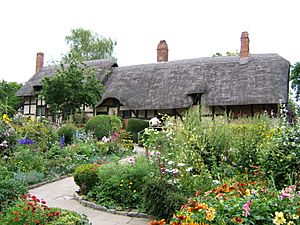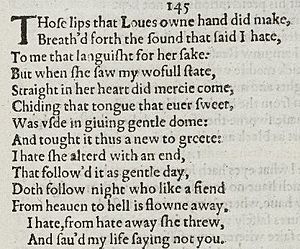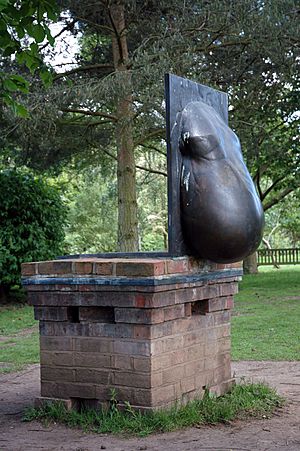Anne Hathaway (wife of Shakespeare) facts for kids
Quick facts for kids
Anne Hathaway
|
|
|---|---|
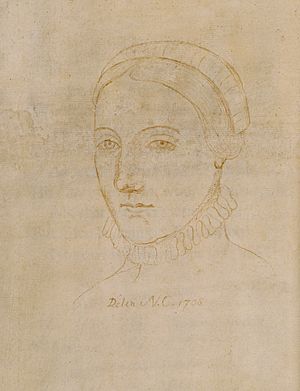
This drawing by Sir Nathaniel Curzon, dated 1708, purportedly depicts Anne Hathaway. Samuel Schoenbaum writes that it is probably a tracing of a lost Elizabethan portrait, but there is no existing evidence that the portrait actually depicted Hathaway.
|
|
| Born | 1556 Shottery, England
|
| Died | 6 August 1623 (aged 66–67) Stratford-upon-Avon, England
|
| Spouse(s) | |
| Children |
|
Anne Hathaway (born 1556, died 6 August 1623) was the wife of William Shakespeare, a famous English writer and actor. They got married in 1582. Anne was 26 years old, and William was 18. She lived for seven years after William passed away. We don't know much about her life, only a few things from old papers. People have wondered a lot about what she was like and how she got along with Shakespeare.
Contents
Where Did Anne Hathaway Live?
Anne Hathaway probably grew up in Shottery, a small village near Stratford-upon-Avon, England. She lived in a farmhouse that belonged to her family. This house is now a popular place for tourists to visit. Her father, Richard Hathaway, was a farmer. He passed away in 1581. In his will, he left Anne some money, which was to be paid when she got married. In his will, her name was written as "Agnes." Because of this, some people think she should be called "Agnes Hathaway."
Anne's Marriage to William Shakespeare
Anne Hathaway married William Shakespeare in November 1582. They had three children together. Their first child, Susanna, was born in 1583. Two years later, in 1585, they had twins, Hamnet and Judith. Sadly, Hamnet died when he was only 11 years old. This happened during a time when a serious illness called the bubonic plague was common. Hamnet was buried in Stratford-upon-Avon in 1596.
We don't have many records about Anne's life, except for her marriage and her children's births. One interesting mention of her is in the will of her father's shepherd, Thomas Whittington, who died in 1601. He left some money to "the poor of Stratford." He added that this money was "in the hand of Anne Shakespeare wife unto Master William Shakespeare." This might mean Anne was holding some money for him, or perhaps it was unpaid wages.
In 1607, Anne's daughter Susanna married a local doctor named John Hall. They had a daughter, Elizabeth, the next year. Elizabeth was Anne and William's only grandchild. In 1616, Judith married Thomas Quiney, who owned a wine shop.
For most of their marriage, William Shakespeare lived in London, where he wrote and performed his plays. Anne stayed in Stratford. However, William would return to Stratford every year. When he stopped working in the theatre in 1613, he chose to live in Stratford with Anne. This shows that he wanted to be with his wife in their home town.
What Did Shakespeare's Will Say About Anne?
In his will, William Shakespeare left his wife Anne only his "second-best bed with the furniture." This has made many people wonder if he didn't like her very much. However, there are a few ideas about why he did this.
- Some experts say that by law, Anne would have received one-third of her husband's property anyway, even if it wasn't in the will.
- It's also thought that Anne might have been financially secure on her own.
- In Shakespeare's time, beds were very valuable. The "best bed" was often kept for guests, so the "second-best bed" might have been the one William and Anne shared. This would mean it was a special and personal gift, not an insult.
The will was changed shortly before Shakespeare died in 1616. It was only then that the "second-best bed" was added for Anne. Some people think this means he almost forgot her, but then remembered her.
Where is Anne Hathaway Buried?
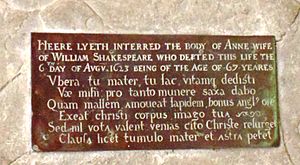
Anne Hathaway is buried next to William Shakespeare in the Church of the Holy Trinity, Stratford-upon-Avon. The words on her tombstone say, "Here lies the body of Anne wife of William Shakespeare who departed this life the 6th day of August 1623 being of the age of 67 years."
Anne Hathaway in Stories and Plays
Anne Hathaway has appeared in many stories, plays, and movies over the years.
Anne in Shakespeare's Sonnets?
Some people think that one of Shakespeare's sonnets, Sonnet 145, might be about Anne Hathaway. The words "hate away" sound like "Hathaway" when spoken in old English. Also, the next words, "And saved my life," could sound like "Anne saved my life." This sonnet is different from Shakespeare's other sonnets because its lines are shorter.
How Anne is Shown in Fiction
In the 1800s, when Shakespeare became very famous, Anne Hathaway started appearing in novels. Early stories often showed her as a loving wife in a happy marriage.
Later, in the 1900s, some writers started to show Anne in a more negative way. She was sometimes shown as a difficult or unhappy wife. However, more recent stories have shown her in many different ways. Some writers use her character to explore ideas about women's independence, education, and relationships.
- In the play A Cry of Players (1968), a young Shakespeare and Anne are shown together.
- The poem "Anne Hathaway" by Carol Ann Duffy is part of her collection The World's Wife.
- The novel Mrs Shakespeare: the Complete Works by Robert Nye is written as if Anne herself is telling her life story.
- The movie Shakespeare in Love shows Anne's marriage as cold and unhappy.
- The novel The Secret Confessions of Anne Shakespeare (2010) even suggests that Anne Hathaway wrote many of Shakespeare's plays!
- Anne is played by Liza Tarbuck in the TV comedy series Upstart Crow.
- Judi Dench plays Anne Hathaway in the 2018 film All Is True.
- In the musical & Juliet, Anne Hathaway is a main character.
- The 2020 novel Hamnet by Maggie O'Farrell tells a fictional story about Shakespeare's family, focusing on the death of their son.
Anne Hathaway's Cottage
Anne Hathaway's childhood home is near Stratford-upon-Avon. Even though it's called a "cottage," it's actually a large, twelve-room farmhouse with many bedrooms. It also has big gardens. In Shakespeare's time, it was known as Hewlands Farm and had a lot of land around it. The house has many chimneys to keep it warm in winter. The biggest chimney was used for cooking. You can also see its wooden frame, which was a common style for houses back then.
After Anne's father died, the cottage stayed in the Hathaway family until 1846. Financial problems made them sell it. Today, the Shakespeare Birthplace Trust owns and manages it. It is open to the public as a museum.
See Also
 In Spanish: Anne Hathaway (Shakespeare) para niños
In Spanish: Anne Hathaway (Shakespeare) para niños
- Shakespeare's Wife (book)


